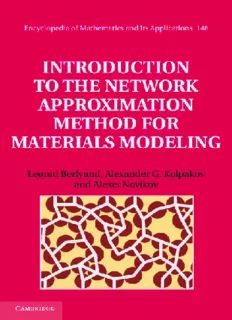Table Of ContentINTRODUCTION TO THE NETWORK APPROXIMATION
METHOD FOR MATERIALS MODELING
Inrecentyearsthetraditionalsubjectofcontinuummechanicshasgrownrapidly
andmanynewtechniqueshaveemerged.Thistextprovidesarigorous,yet
accessibleintroductiontothebasicconceptsofthenetworkapproximation
methodandprovidesaunifiedapproachforsolvingawidevarietyofapplied
problems.
Asaunifyingtheme,theauthorsdiscussindetailthetransportproblemina
systemofbodies.Theysolvetheproblemofcloselyplacedbodiesusingthenew
methodofthenetworkapproximationforpartialdifferentialequationswith
discontinuouscoefficients.
Intendedforgraduatestudentsinappliedmathematicsandrelatedfieldssuch
asphysics,chemistryandengineering,thebookisalsoausefuloverviewofthe
topicforresearchersintheseareas.
EncyclopediaofMathematicsandItsApplications
Thisseriesisdevotedtosignificanttopicsorthemesthathavewideapplicationin
mathematicsormathematicalscienceandforwhichadetaileddevelopmentof
theabstracttheoryislessimportantthanathoroughandconcreteexplorationof
theimplicationsandapplications.
BooksintheEncyclopediaofMathematicsandItsApplicationscovertheir
subjectscomprehensively.Lessimportantresultsmaybesummarizedas
exercisesattheendsofchapters.Fortechnicalities,readerscanbereferredtothe
bibliography,whichisexpectedtobecomprehensive.Asaresult,volumesare
encyclopedicreferencesormanageableguidestomajorsubjects.
Encyclopedia of Mathematics and its Applications
AllthetitleslistedbelowcanbeobtainedfromgoodbooksellersorfromCambridge
UniversityPress.Foracompleteserieslistingvisit
www.cambridge.org/mathematics.
95 Y.JabriTheMountainPassTheorem
96 G.GasperandM.RahmanBasicHypergeometricSeries,2ndedn
97 M.C.PedicchioandW.Tholen(eds.)CategoricalFoundations
98 M.E.H.IsmailClassicalandQuantumOrthogonalPolynomialsinOneVariable
99 T.MoraSolvingPolynomialEquationSystemsII
100 E.OlivieriandM.Eula´liaVaresLargeDeviationsandMetastability
101 A.Kushner,V.LychaginandV.RubtsovContactGeometryandNonlinearDifferentialEquations
102 L.W.BeinekeandR.J.Wilson(eds.)withP.J.CameronTopicsinAlgebraicGraphTheory
103 O.J.StaffansWell-PosedLinearSystems
104 J.M.Lewis,S.LakshmivarahanandS.K.DhallDynamicDataAssimilation
105 M.LothaireAppliedCombinatoricsonWords
106 A.MarkoeAnalyticTomography
107 P.A.MartinMultipleScattering
108 R.A.BrualdiCombinatorialMatrixClasses
109 J.M.BorweinandJ.D.VanderwerffConvexFunctions
110 M.-J.LaiandL.L.SchumakerSplineFunctionsonTriangulations
111 R.T.CurtisSymmetricGenerationofGroups
112 H.Salzmannetal.TheClassicalFields
113 S.PeszatandJ.ZabczykStochasticPartialDifferentialEquationswithLe´vyNoise
114 J.BeckCombinatorialGames
115 L.BarreiraandY.PesinNonuniformHyperbolicity
116 D.Z.ArovandH.DymJ-ContractiveMatrixValuedFunctionsandRelatedTopics
117 R.Glowinski,J.-L.LionsandJ.HeExactandApproximateControllabilityforDistributedParameter
Systems
118 A.A.BorovkovandK.A.BorovkovAsymptoticAnalysisofRandomWalks
119 M.DezaandM.DutourSikiric´GeometryofChemicalGraphs
120 T.NishiuraAbsoluteMeasurableSpaces
121 M.PrestPurity,SpectraandLocalisation
122 S.KhrushchevOrthogonalPolynomialsandContinuedFractions
123 H.NagamochiandT.IbarakiAlgorithmicAspectsofGraphConnectivity
124 F.W.KingHilbertTransformsI
125 F.W.KingHilbertTransformsII
126 O.CalinandD.-C.ChangSub-RiemannianGeometry
127 M.Grabischetal.AggregationFunctions
128 L.W.BeinekeandR.J.Wilson(eds.)withJ.L.GrossandT.W.TuckerTopicsinTopologicalGraph
Theory
129 J.Berstel,D.PerrinandC.ReutenauerCodesandAutomata
130 T.G.FaticoniModulesoverEndomorphismRings
131 H.MorimotoStochasticControlandMathematicalModeling
132 G.SchmidtRelationalMathematics
133 P.KornerupandD.W.MatulaFinitePrecisionNumberSystemsandArithmetic
134 Y.CramaandP.L.Hammer(eds.)BooleanModelsandMethodsinMathematics,ComputerScience,
andEngineering
135 V.Berthe´andM.Rigo(eds.)Combinatorics,AutomataandNumberTheory
136 A.Krista´ly,V.D.Ra˘dulescuandC.VargaVariationalPrinciplesinMathematicalPhysics,Geometry,
andEconomics
137 J.BerstelandC.ReutenauerNoncommutativeRationalSerieswithApplications
138 B.CourcelleGraphStructureandMonadicSecond-OrderLogic
139 M.FiedlerMatricesandGraphsinGeometry
140 N.VakilRealAnalysisthroughModernInfinitesimals
141 R.B.ParisHadamardExpansionsandHyperasymptoticEvaluation
142 Y.CramaandP.L.HammerBooleanFunctions
143 A.Arapostathis,V.S.BorkarandM.K.GhoshErgodicControlofDiffusionProcesses
144 N.Caspard,B.LeclercandB.MonjardetFiniteOrderedSets
145 D.Z.ArovandH.DymBitangentialDirectandInverseProblemsforSystemsofIntegraland
DifferentialEquations
146 G.DassiosEllipsoidalHarmonics
147 L.W.BeinekeandR.J.Wilson(eds.)withO.R.OellermannTopicsinStructuralGraphTheory
Encyclopedia of Mathematics and its Applications
Introduction to the Network
Approximation Method for
Materials Modeling
LEONID BERLYAND
PennsylvaniaStateUniversity
ALEXANDER G. KOLPAKOV
Universita`degliStudidiCassinoedelLazioMeridionale
ALEXEI NOVIKOV
PennsylvaniaStateUniversity
cambridge university press
Cambridge,NewYork,Melbourne,Madrid,CapeTown,
Singapore,Sa˜oPaulo,Delhi,MexicoCity
CambridgeUniversityPress
TheEdinburghBuilding,CambridgeCB28RU,UK
PublishedintheUnitedStatesofAmericabyCambridgeUniversityPress,NewYork
www.cambridge.org
Informationonthistitle:www.cambridge.org/9781107028234
(cid:2)C LeonidBerlyand,AlexanderG.KolpakovandAlexeiNovikov2013
Thispublicationisincopyright.Subjecttostatutoryexception
andtotheprovisionsofrelevantcollectivelicensingagreements,
noreproductionofanypartmaytakeplacewithoutthewritten
permissionofCambridgeUniversityPress.
Firstpublished2013
PrintedandboundintheUnitedKingdombytheMPGBooksGroup
AcataloguerecordforthispublicationisavailablefromtheBritishLibrary
LibraryofCongressCataloguinginPublicationdata
Berlyand,Leonid,1957–
Introductiontothenetworkapproximationmethodformaterialsmodeling/LeonidBerlyand,
PennsylvaniaStateUniversity,AlexanderG.Kolpakov,Universita`degliStudidiCassinoedelLazio
Meridionale,A.Novikov,PennsylvaniaStateUniversity.
pages cm.–(Encyclopediaofmathematicsanditsapplications)
Includesbibliographicalreferencesandindex.
ISBN978-1-107-02823-4(hardback)
1.Compositematerials–Mathematicalmodels. 2.Graphtheory. 3.Differentialequations,
Partial. 4.Dualitytheory(Mathematics) I.Kolpakov,A.G. II.Novikov,A.(Alexei) III.Title.
TA418.9.C6B465 2013
620.1(cid:3)18015115–dc23 2012029156
ISBN978-1-107-02823-4Hardback
CambridgeUniversityPresshasnoresponsibilityforthepersistenceor
accuracyofURLsforexternalorthird-partyinternetwebsitesreferredto
inthispublication,anddoesnotguaranteethatanycontentonsuch
websitesis,orwillremain,accurateorappropriate.
“Tomymotherandgreatsupporter,MayyaBerlyand”.
L.Berlyand
“WithfondmemoriesofmywonderfultimeatPennState”.
A.Kolpakov
“Tomymother”.
A.Novikov
Contents
Preface pagex
1 Reviewofmathematicalnotionsusedintheanalysisof
transportproblemsindensely-packedcompositematerials 1
1.1 Graphs 1
1.2 Functionalspacesandweaksolutionsofpartialdifferential
equations 3
1.3 Dualityoffunctionalspacesandfunctionals 9
1.4 Differentiationinfunctionalspaces 12
1.5 Introductiontoellipticfunctiontheory 13
1.6 Kirszbraun’stheorem 18
2 Backgroundandmotivationfortheintroductionof
networkmodels 20
2.1 Examplesofreal-worldproblemsleadingtodiscrete
networkmodels 20
2.2 Examplesofnetworkmodels 22
2.3 Rigorousmathematicalapproaches 27
2.4 Whendoesnetworkmodelingwork? 28
2.5 Historyofthemathematicalinvestigationofoverall
propertiesofhigh-contrastmaterialsandarraysofbodies 35
2.6 Berryman–Borcea–PapanicolaouanalysisoftheKozlov
model 42
2.7 NumericalanalysisoftheMaxwell–Kellermodel 44
2.8 Percolationindisorderedsystems 49
2.9 Summary 50
viii Contents
3 Networkapproximationforboundary-valueproblemswith
discontinuouscoefficientsandafinitenumberofinclusions 51
3.1 Variationalprinciplesandduality.Two-sidedbounds 52
3.2 Compositematerialwithhomogeneousmatrix 57
3.3 Trialfunctionsandtheaccuracyoftwo-sidedbounds.
Constructionoftrialfunctionsforhigh-contrast
densely-packedcompositematerials 63
3.4 Constructionofaheuristicnetworkmodel.Two-dimensional
transportproblemforahigh-contrastcompositematerial
filledwithdenselypackedparticles 65
3.5 Asymptoticallymatchingbounds 69
3.6 Proofofthenetworkapproximationtheorem 71
3.7 Close-packingsystemsofbodies 88
3.8 Finishoftheproofofthenetworkapproximationtheorem 90
3.9 Thepseudo-diskmethodandRobinboundaryconditions 98
4 Numericsforpercolationandpolydispersityvianetworkmodels 100
4.1 Computationoffluxbetweentwocloselyspaceddisksof
differentradiiusingtheKellermethod 100
4.2 Conceptofneighborsusingcharacteristicdistances 102
4.3 Numericalimplementationofthediscretenetwork
approximationandfluxesinthenetwork 104
4.4 Propertyoftheself-similarityproblem(3.2.4)–(3.2.7) 105
4.5 Numericalsimulationsformonodispersedcomposite
materials.Thepercolationphenomenon 106
4.6 Polydisperseddensely-packedcompositematerials 110
5 Thenetworkapproximationtheoremforaninfinite
numberofbodies 116
5.1 Formulationofthemathematicalmodel 116
5.2 Triangle–neckpartitionanddiscretenetwork 119
5.3 Perturbednetworkmodels 129
5.4 δ-Nconnectednessandδ-subgraphs 129
5.5 Propertiesofthediscretenetwork 131
5.6 Variationalerrorestimates 135
5.7 Therefinedlower-sidedbound 136
5.8 Therefinedupper-sidedbound 138
5.9 Constructionoftrialfunctionfortheupper-sidedbound 138
5.10 Thenetworkapproximationtheoremwithanerrorestimate
independentofthetotalnumberofparticles 145
5.11 Estimationoftheconstantinthenetworkapproximation
theorem 147
5.12 Aposteriorinumericalerror 151
Contents ix
6 Networkmethodfornonlinearcomposites 155
6.1 Formulationofthemathematicalmodel 156
6.2 Atwo-stepconstructionofthenetwork 157
6.3 Proofsforthedomainpartitioningstep 163
6.4 Proofsfortheasymptoticstep 174
7 Networkapproximationforpotentialsofbodies 180
7.1 Formulationoftheproblemofapproximationofpotentials
ofbodies 180
7.2 Networkapproximationtheoremforpotentials 182
8 Applicationofthemethodofcomplexvariables 191
8.1 R-linearproblemandfunctionalequations 191
8.2 Doubly-periodicproblems 204
8.3 Optimaldesignproblemformonodispersedcomposites 213
8.4 Randompolydispersedcomposite 217
References 228
Index 242
Description:In recent years the traditional subject of continuum mechanics has grown rapidly and many new techniques have emerged. This text provides a rigorous, yet accessible introduction to the basic concepts of the network approximation method and provides a unified approach for solving a wide variety of ap

